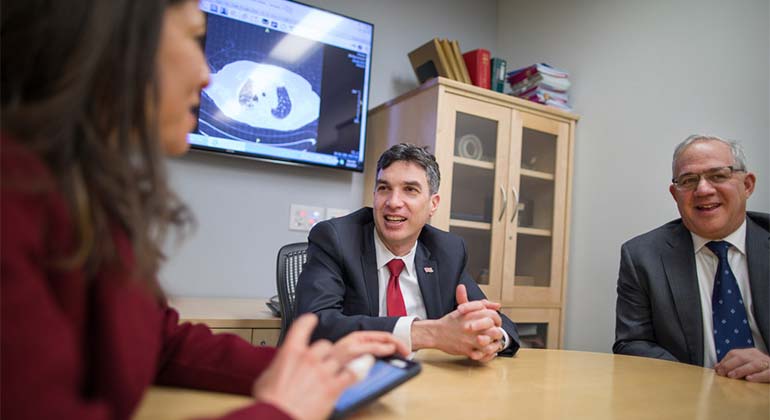Robotic Thoracic Surgery

Thoracic surgery is an integral part of the Mount Sinai Robotics Institute. Our surgeons use robotic technology to treat the heart, lungs, esophagus, and other organs in the chest. Even if you are a candidate for open surgery, you may still benefit from robotic procedures. In fact, it may produce better outcomes, smaller scars, and quicker recovery.
Our robotic thoracic surgeons perform procedures while you are under general anesthesia. We insert a pen-sized tube (cannula) with a camera on the end to improve visibility inside your chest. Then we insert one or two additional cannulae with fully flexible instruments on the end. One surgeon sits at a console, manipulating the instruments using a joystick, while another surgeon sits at your bedside. Most procedures take one to three hours.
Thoracic Conditions We Treat with Robotic Surgery
We treat a variety of thoracic conditions with robotic technology, including cancers and low-grade tumors. The diseases we see most often are:
Cancers
- Esophageal cancer
- Lung cancer
- Mediastinal tumors (including thymoma, teratoma, and germ cell tumors)
- Thymoma
Low-Grade Tumors
- Chest wall and pleural tumors, including fibrous tumors of the pleura
- Schwannoma and neurogenic tumors
Benign Disorders
- Achalasia
- Gastroesophageal reflux disease
- Hyperhydrosis reversal
- Interstitial lung diseases
- Lung nodule resections
- Thymectomy for myasthenia gravis
Types of Robotic Thoracic Procedures Offered at Mount Sinai
To treat the above conditions, Mount Sinai’s thoracic surgery team performs a broad spectrum of procedures including:
- Anti-reflux operations
- Heller myotomy
- Minimally invasive esophagectomy
- Navigation-guided precision lung resections
- Nissen fundoplication
- Paraesophageal hernia repair
- Repair of diaphragmatic hernia
- Resection of chest wall and pleural tumors
- Robot-assisted lobectomy, segmentectomy, and other lung resections
- Robot-assisted thymectomy
- Sympathectomy and reversal of sympathectomy
- Tracheal procedures
Patient Benefits of Robotic Thoracic Surgery
For qualified candidates, a robotic surgical approach may be an option. Robotic surgery is minimally invasive, which means we do not need to open your chest wall. Instead, we perform the procedures with a few small instruments. Robotic surgery also allows us to see what is happening in the chest more clearly. The camera provides 3D images that we can magnify to ten times the actual size. Open surgery offers two-dimensional views. We also use small instruments that give us great dexterity and precision.
For patients, robotic surgery offers numerous advantages:
- Decreased risk of wound infection
- Minimal scarring because the incisions are so small
- Faster recuperation and return to normal activities (including work)
- Reduced pain and discomfort, which means less use of narcotics
- Shorter hospital stays; an open procedure often requires five to seven days in the hospital while a robotic procedure typically entails a two- or three-day stay
- Similar or less blood loss and need for transfusion
Recovery and Follow-Up Care after Robotic Surgery
Depending on the surgical procedure, you may spend a night in the intensive care unit so we can keep monitor you. We want to make sure there is no change in your heart rhythm. We usually insert a drain to prevent accumulation of fluid in the surgical site. Often, we can remove this a day or two after the procedure.
If you have robotic surgery, you should be able to go home sooner than people who have had open surgery. However, if the procedure is more complex, you may need to spend several nights in the hospital.
Once you have returned home, a home visiting nurse will come by every day to check the incisions and answer any questions you or your family may have. At two weeks post-procedure, you will come back to see your surgeon.
We usually do not place specific restrictions on daily routines. We generally recommend you do only what feels comfortable; if it hurts, stop. You should be able to return to normal activities within two weeks.